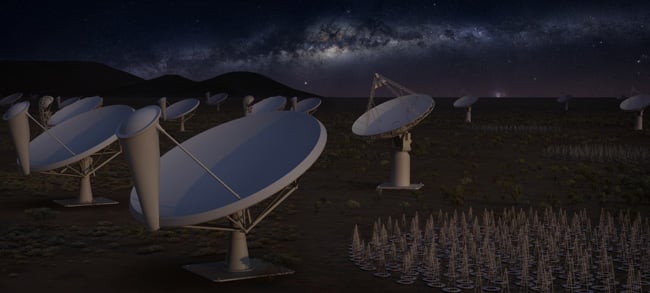This article is more than 1 year old
Building the world's biggest telescope array - with machines that don't yet exist
Turning terabytes and exabytes into galaxies at SKA
Writing software for something that doesn't exist. Uh, what?
“We know what we would do, but writing the software to facilitate this is quite tricky,” said Cornwell. “It’s about an 80m euro job to do that and it’s quite a substantial job. Software is always a risk so I would say that’s one of the biggest challenges.

The SKA: 126 tennis courts, if they looked like radio arrays
“The processing that we do is extremely complex. We get the information from the telescope and it tells us in a very roundabout way what the sky looks like and we have to go through that and figure out what the sky actually looks like for the images,” Cornwell explained.
“That’s a huge amount of processing to do. We’ve gotten very good at that over the past 40 years or so, but the algorithms are very complex and we’re basically going about a factor of a thousand up in processing scale from existing telescopes,” he continued. “The two telescopes that do this already are the Australian Square Kilometre Array Pathfinder [ASKAP] and the Low Frequency Array [LOFAR], and they operate at about a few hundred teraflops and we have to operate at a hundred or a few hundred petaflops – so it’s a huge jump in five years. No-one really knows exactly how to write the software to do this - we have an idea, but it has to be tested.”
Despite the challenges though, Cornwell is feeling pretty confident, because this is what global science projects are all about.
“We’ve done this before – we’ve been doing it for years,” he said.
“I worked on ASKAP and I remember when I started the programme in 2007, thinking: ‘We’re not going to be able to do that,’ but we did it. The way you do it is incrementally, step by step as the processors get better. So I think it can be done, obviously we wouldn’t be able to attract the funding and the support if we couldn’t make a convincing case that we can. But it’s not a done deal.
“We design the telescope for the computers we’re going to have when we start observing, not the ones we have now. We’re reasonably optimistic that we can do it, but there will undoubtedly be stumbles along the way. But that’s what research is about; if you want to build a world class instrument – and this is basically the best radio telescope anyone’s going to build for a while – you have to take these educated chances,” he said.
To build something like this, Cornwell and the SKA team work with the teams of radio astronomy projects like ASKAP and LOFAR and even pull inspiration from other big data science projects like the Large Hadron Collider (LHC).
“We very much looked at other big projects for multiple lines of insight. One is the LHC and the way that they do their data dissemination. They have multiple tiers of users and we’ll probably end up with something like that,” he said.
“We also looked at the Large Synoptic Survey Telescope (LSST) and we’ve also talked to LOFAR, who are part of the team developing the software for our telescope. You really can’t do something like this unless you’re connected to other state of the art projects.”
